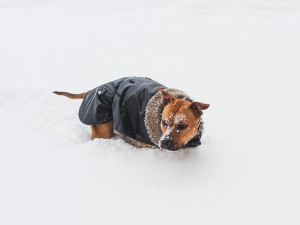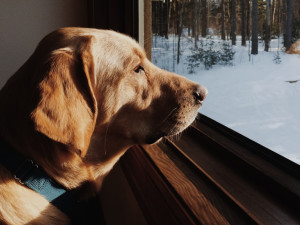How Cold is Too Cold for Dogs?
If your teeth are chattering, theirs probably are, too

Share Article
In this article:
What temperature is too cold? What factors affect cold tolerance in dogs How do I know if my dog is cold? Signs of dogs experiencing cold stress Tips for ensuring dog safety in cold temperatures
So, it’s officially winter, and we can all agree it’s been uncomfortably cold in some parts of the country. It’s the kind of cold where you put thermals on under your jeans and think, ‘Is this my life now?‘
But how does your pup feel in these temps? The cold temperature tolerance of dogs varies depending on their breed, size, coat type, age, activity level and overall health. In general, some dogs may start to become uncomfortable at temperatures where a person would want a jacket, and temperatures below freezing pose a risk of hypothermia and frostbite. Any dog out in cold weather should be monitored closely to avoid potential health hazards.
What temperature is too cold for dogs?
Every dog’s tolerance for cold is different. A Siberian Husky’s thick double coat will keep them considerably warmer than a Chinese Crested’s thin tufts of hair. In general, dogs should be monitored for signs that they are getting cold if they’re outdoors for extended periods in temperatures in which a person would want to wear a jacket. Because of the variation in dog breeds and sizes, it’s impossible to give a temperature that is too cold for all dogs.
A medium or large breed dog with a normal coat and no health issues, should stay in an indoor environment warmer than 10C. This could feel pretty chilly to some dogs, though, especially dogs who are used to a cushy life in a heated house. A dog’s tolerance for low temperatures can vary even more when they’re outside because other environmental factors play a role as well.
What other weather factors impact what temperature is suitable for dogs?
Dogs will feel significantly colder if they’re exposed to the elements. While lying out in the sun on a cool day may be fine, dealing with adverse weather conditions can make that same temperature seem much colder. Some factors that affect how temperature is perceived include:
wind
relative humidity
rain, snow or sleet
time of day
sunny or cloudy conditions
Exposure to the elements introduces a lot of uncertainty in determining how a dog will handle a given temperature. Dogs with good shelter and bedding (ideally indoors) to retreat to can decide to protect themselves from adverse conditions.
What factors affect cold tolerance in dogs?
Every dog’s ability to tolerate cold is different. Dogs can gradually adjust (acclimatise) to cooler temperatures if they’re exposed to them gradually. Other factors that affect cold tolerance in dogs include:
Breed
Northern breeds and dogs with heavy coats tolerate cold weather much better than thin-coated breeds. Heavy coats help trap heat and protect from wind and dampness. Dog breeds from cold climates also tend to have thick-haired tails and feet that help prevent heat loss.
Size
Large dogs are better at handling cold than small dogs. Radiation of heat from the skin can result in significant heat loss. Large dogs have a smaller body surface area relative to their weight than small dogs, leading to less radiation and better heat retention.
Age
Young puppies and senior dogs are both more sensitive to temperature changes and can get cold more easily. This is due to changes in metabolism and differences in blood flow to the skin.
Health
Numerous health conditions affect how the body regulates its temperature. Hypothyroidism is a common condition in dogs and slows their metabolism, making it harder for them to stay warm. Other problems like heart disease, kidney disease, neurological issues and cancer can all affect a dog’s ability to stay warm.
Activity level
Dogs who are able to stay active while in a cold environment are less likely to develop problems. Muscle activity creates heat and helps dogs to stay warm. Dogs who are unable to run and play in the cold will get chilly faster than those who are moving around constantly.
Dampness
Dogs who get wet and are not dried completely are at increased risk of complications from the cold. Being wet affects their ability to maintain their temperature due to heat loss through the water.
How do I know if my dog is cold?
Cold dogs will display some common behaviours that can clue you in to their discomfort. The most common symptoms are related to heat-seeking behaviour. Dogs are smart and know when it’s time to get warm, but these behaviours may not be obvious if you don’t know what to watch for. Be on the lookout for symptoms like:
curling up
burrowing under blankets or other objects
piloerection (raised hair)
cold extremities (feet, ears, nose, gums)
shivering
You might think that all cold dogs will shiver, but the shivering reflex turns off when a dog’s body temperature drops below 34.4C. Dogs can rapidly become unable to activate their body’s protective measures to maintain a normal temperature in very cold conditions. Recognising the signs of problems early on can prevent bigger issues.
What are the signs my dog is experiencing cold stress?
Dogs experiencing early signs of cold stress will initially show symptoms like those listed above. Hypothermia can progress through various stages as dogs get colder and colder. A normal dog’s body temperature is 37.8–39.2C. Hypothermia comes in four stages:
Mild: 32–37C body temperature
Moderate: 28–32C body temperature
Severe: 20–28C body temperature
Profound: less than 20C body temperature
Each stage of hypothermia results in worsening the body’s ability to regulate its temperature, maintain brain and heart function, and preserve blood flow. Dogs experiencing cold stress will become progressively lethargic, weak and mentally dull.
Dogs in very cold conditions can also develop problems due to frostbite. Frostbite can develop at temperatures above freezing if there is a severe wind chill or exposure to water. Frostbite occurs when the body cuts off the blood supply to the exposed area to try to maintain heat.
Without a steady blood supply, cells begin to die off. Water in the exposed tissues can also freeze, causing the cells to rupture. In dogs, frostbite occurs most commonly in the extremities like the paws, tail tip, eyelids, scrotum, nose and ears. Frostbite is not common in dogs, but it can result in the loss of affected body parts.
How can I ensure my dog stays safe in cold temperatures?
Some people enjoy being out in cold weather and dogs are no different. Even if they enjoy cold temperatures, pups still need some protection from the elements and watchful parents to make sure they’re not having problems. Don’t leave your dog outside unsupervised in cold temperatures, especially if it’s wet or windy.
If you’re ever worried that your dog has gotten too cold or may have frostbite, take them to your vet as soon as possible. They can assess your their body temperature, warm them safely and make sure that there are no lingering issues from the cold. The best way to prevent problems from the cold is to be proactive about keeping your dog warm.
Keep time outdoors in the cold limited and try to keep your dog active and moving while they’re outside. Watch closely for any signs of cold stress or hypothermia. If you ever have any doubts about how your dog is handling the cold, take them back inside to warm up. It’s best to provide a cosy blanket and a warm environment. Avoid heat pads and heat lamps because they can cause burns, especially on cold skin that doesn’t have the best blood supply.
Thin-coated or hairless dogs can benefit from sweaters or jackets to help protect them from the elements. Dogs who walk on icy surfaces or roads treated with rock salt or other chemicals may benefit from booties to protect their feet. Many pups don’t initially enjoy the way booties feel when they’re walking, so it’s best to introduce them gradually while the weather is more pleasant. Dogs can do great in cold weather, but it’s up to their parents to make good decisions regarding safety.
Frequently asked questions
What breeds are more tolerant of cold weather?
Northern breeds with thick double coats tend to do better in cold weather. Breeds like Siberian Huskies, Alaskan Malamutes, Newfoundlands, Bernese Mountain Dogs and Saint Bernards were all bred for cold weather activities.
Can I leave my dog in the car during cold weather?
While the risks of problems are lower in the winter than during the summer, it’s still not advisable to leave your dog in the car when it’s cold. Temperatures can drop quickly once the engine is off, creating a dangerous environment for your dog.
Can dogs get frostbite or hypothermia?
Dogs can get both frostbite and hypothermia from exposure to cold conditions. Keeping your dog safe from the cold can prevent complications from these serious problems.
References
USDA - Animal Welfare Act Quick Reference Guidesopens in new tab
Cold Critters: Assessing, Preventing, and Treating Hypothermiaopens in new tab
Spontaneous Resolution of Hypothermia-Induced Atrial Fibrillation in a dogopens in new tab
Hypothermia and Targeted Temperature Management in Cats and Dogsopens in new tab

Dr. Bartley Harrison, DVM
Dr. Bartley Harrison is a veterinarian with more than 19 years of experience. He has treated a variety of species in emergency and speciality practices for both large and small animals. His primary interests as a vet are emergency medicine and critical care.
Related articles

What Happens If You Don’t Take Your Dog For a Walk?
And what you can do inside instead

How Do I Get My Dog to Wear a Winter Coat?
Chilly pup refusing to layer? Here’s how to train them to love their winter wardrobe

The Chilling Truth About Dog Frostbite
Yep, all those warnings your mum gave you as a kid apply to your dog, too. Learn how to keep your pup safe in the cold

When Is it Too Cold to Take My Dog For a Walk?
It’s not as simple as one universal temperature for all



